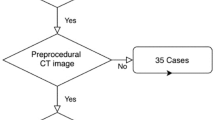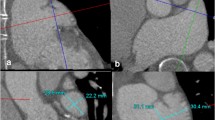Abstract
Aim
To investigate the role of cardiac CT angiography (CCTA) in predicting optimal left atrial appendage (LAA) occluder size and procedure outcome.
Methods and results
Thirty-six patients underwent pre-procedural CCTA. CCTA and TEE LAA orifice diameters and perimeters were compared with the implanted device size. CCTA 3D configuration was correlated with procedure outcome. Watchman™ device (N = 18): diameters were 21 ± 4, 26 ± 5 and 25 ± 3 mm for TEE, CCTA and inserted device, respectively. Average perimeters were 61 ± 10, 74 ± 8 and 78 ± 11 mm for TEE, CCTA and inserted device, respectively. Better agreement with the device size was found for CCTA compared to TEE (Bland–Altman). ACP™ device (N = 15): diameters were 20 ± 5, 25 ± 4 and 23 ± 4 for TEE, CCTA and inserted device, respectively. Average perimeters were 58 ± 11, 72 ± 15 and 72 ± 13 mm for TEE, CCTA and inserted device, respectively. Excellent correlation and agreement with the device size was found for CCTA compared to TEE. CCTA perimeter >100 mm and “cactus” 3D configuration had a specificity of 96 and 81% respectively for procedure failure.
Conclusions
CCTA LAA ostial perimeter predicted better the optimal occluder size as compared with the currently used LAA TEE diameter. Moreover, CCTA 3D data may help in predicting potential complications.




Similar content being viewed by others
References
Stoddard MF, Dawkins PR, Prince CR, Ammash NM (1995) Left atrial appendage thrombus is not uncommon in patients with acute atrial fibrillation and a recent embolic event: a transesophageal echocardiographic study. J Am Coll Cardiol 25:452–459
Go AS, Hylek EM, Borowsky LH, Phillips KA, Selby JV, Singer DE (1999) Warfarin use among ambulatory patients with nonvalvular atrial fibrillation: the anticoagulation and risk factors in atrial fibrillation (ATRIA) study. Ann Intern Med 131:927–934
Belgaid DR, Khan Z, Zaidi M Hobbs A (2016) Prospective randomized evaluation of the watchman left atrial appendage closure device in patients with atrial fibrillation versus long-term warfarin therapy: The PREVAIL trial. Int J Cardiol 219:177–179
Boersma LV, Schmidt B, Betts TR, Sievert H, Tamburino C, Teiger E, Pokushalov E, Kische S, Schmitz T, Stein KM, Bergmann MW (2016) Implant success and safety of left atrial appendage closure with the WATCHMAN device: peri-procedural outcomes from the EWOLUTION registry. Eur Heart J 37:2465–2474
Holmes CB, Williams-Sherlock MA, Bouey PD (2009) Monitoring and evaluation of PEPFAR treatment programmes. Lancet 374:1146–1147
Holmes DR Jr, Doshi SK, Kar S, Price MJ, Sanchez JM, Sievert H, Valderrabano M, Reddy VY (2015) Left atrial appendage closure as an alternative to warfarin for stroke prevention in atrial fibrillation: a patient-level meta-analysis. J Am Coll Cardiol 65:2614–2623
Holmes DR Jr, Kar S, Price MJ, Whisenant B, Sievert H, Doshi SK, Huber K, Reddy VY (2014) Prospective randomized evaluation of the Watchman Left Atrial Appendage Closure device in patients with atrial fibrillation versus long-term warfarin therapy: the PREVAIL trial. J Am Coll Cardiol 64:1–12
Ostermayer SH, Reisman M, Kramer PH, Matthews RV, Gray WA, Block PC, Omran H, Bartorelli AL, Della Bella P, Di Mario C, Pappone C, Casale PN, Moses JW, Poppas A, Williams DO, Meier B, Skanes A, Teirstein PS, Lesh MD, Nakai T, Bayard Y, Billinger K, Trepels T, Krumsdorf U, Sievert H (2005) Percutaneous left atrial appendage transcatheter occlusion (PLAATO system) to prevent stroke in high-risk patients with non-rheumatic atrial fibrillation: results from the international multi-center feasibility trials. J Am Coll Cardiol 46:9–14
Park JW, Leithauser B, Gerk U, Vrsansky M, Jung F (2009) Percutaneous left atrial appendage transcatheter occlusion (PLAATO) for stroke prevention in atrial fibrillation: 2-year outcomes. J Invasive Cardiol 21:446–450
Tzikas A, Shakir S, Gafoor S, Omran H, Berti S, Santoro G, Kefer J, Landmesser U, Nielsen-Kudsk JE, Cruz-Gonzalez I, Sievert H, Tichelbacker T, Kanagaratnam P, Nietlispach F, Aminian A, Kasch F, Freixa X, Danna P, Rezzaghi M, Vermeersch P, Stock F, Stolcova M, Costa M, Ibrahim R, Schillinger W, Meier B, Park JW (2016) Left atrial appendage occlusion for stroke prevention in atrial fibrillation: multicentre experience with the AMPLATZER Cardiac Plug. EuroIntervention 11:1170–1179
Di Biase L, Santangeli P, Anselmino M, Mohanty P, Salvetti I, Gili S, Horton R, Sanchez JE, Bai R, Mohanty S, Pump A, Cereceda Brantes M, Gallinghouse GJ, Burkhardt JD, Cesarani F, Scaglione M, Natale A, Gaita F (2012) Does the left atrial appendage morphology correlate with the risk of stroke in patients with atrial fibrillation? results from a multicenter study. J Am Coll Cardiol 60:531–538
Veinot JP, Harrity PJ, Gentile F, Khandheria BK, Bailey KR, Eickholt JT, Seward JB, Tajik AJ, Edwards WD (1997) Anatomy of the normal left atrial appendage: a quantitative study of age-related changes in 500 autopsy hearts: implications for echocardiographic examination. Circulation 96:3112–3115
Chue CD, de Giovanni J, Steeds RP (2011) The role of echocardiography in percutaneous left atrial appendage occlusion. Eur J Echocardiogr 12:i3–i10
Meier B, Blaauw Y, Khattab AA, Lewalter T, Sievert H, Tondo C, Glikson M (2014) EHRA/EAPCI expert consensus statement on catheter-based left atrial appendage occlusion. Europace 16:1397–1416
Camm AJ, Lip GY, de Caterina R, Savelieva I, Atar D, Hohnloser SH, Hindricks G, Kirchhof P (2012) 2012 focused update of the ESC Guidelines for the management of atrial fibrillation: an update of the 2010 ESC Guidelines for the management of atrial fibrillation. Developed with the special contribution of the European Heart Rhythm Association. Eur Heart J 33:2719–2747
Budge LP, Shaffer KM, Moorman JR, Lake DE, Ferguson JD, Mangrum JM (2008) Analysis of in vivo left atrial appendage morphology in patients with atrial fibrillation: a direct comparison of transesophageal echocardiography, planar cardiac CT, and segmented three-dimensional cardiac CT. J Interv Card Electrophysiol 23:87–93
Lacomis JM, Goitein O, Deible C, Moran PL, Mamone G, Madan S, Schwartzman D (2007) Dynamic multidimensional imaging of the human left atrial appendage. Europace 9:1134–1140
Walker DT, Humphries JA, Phillips KP (2012) Anatomical analysis of the left atrial appendage using segmented, three-dimensional cardiac CT: a comparison of patients with paroxysmal and persistent forms of atrial fibrillation. J Interv Card Electrophysiol 34:173–179
Wang Y, Di Biase L, Horton RP, Nguyen T, Morhanty P, Natale A (2010) Left atrial appendage studied by computed tomography to help planning for appendage closure device placement. J Cardiovasc Electrophysiol 21:973–982
Ramanujan S. (1914) Modular equations and approximations to π. Quart J Pure App Math 45:350–372.
Saw J, Lopes JP, Reisman M, McLaughlin P, Nicolau S, Bezerra HG (2016) Cardiac computed tomography angiography for left atrial appendage closure. Can J Cardiol 32(1033):e1–e9
Jaguszewski M, Manes C, Puippe G, Salzberg S, Muller M, Falk V, Luscher T, Luft A, Alkadhi H Landmesser U (2015) Cardiac CT and echocardiographic evaluation of peri-device flow after percutaneous left atrial appendage closure using the AMPLATZER cardiac plug device. Catheter Cardiovasc Interv 85:306–312
Saw J, Fahmy P, DeJong P, Lempereur M, Spencer R, Tsang M, Gin K, Jue J, Mayo J, McLaughlin P, Nicolaou S (2015) Cardiac CT angiography for device surveillance after endovascular left atrial appendage closure. Eur Heart J Cardiovasc Imaging 16:1198–1206
Lopez-Minguez JR, Gonzalez-Fernandez R, Fernandez-Vegas C, Millan-Nunez V, Fuentes-Canamero ME, Nogales-Asensio JM, Doncel-Vecino J, Yuste DM, Garcia SL, Sanchez Quintana D (2014) Comparison of imaging techniques to assess appendage anatomy and measurements for left atrial appendage closure device selection. J Invasive Cardiol 26:462–467
Krishnaswamy A, Patel NS, Ozkan A, Agarwal S, Griffin BP, Saliba W, Tuzcu EM, Schoenhagen P, Kapadia SR (2012) Planning left atrial appendage occlusion using cardiac multidetector computed tomography. Int J Cardiol 158:313–317
Viles-Gonzalez JF, Kar S, Douglas P, Dukkipati S, Feldman T, Horton R, Holmes D, Reddy VY (2012) The clinical impact of incomplete left atrial appendage closure with the Watchman Device in patients with atrial fibrillation: a PROTECT AF (percutaneous closure of the left atrial appendage versus warfarin therapy for prevention of stroke in patients with atrial fibrillation) substudy. J Am Coll Cardiol 59:923–929
Hamdan A, Guetta V, Konen E, Goitein O, Segev A, Raanani E, Spiegelstein D, Hay I, Di Segni E, Eldar M, Schwammenthal E (2012) Deformation dynamics and mechanical properties of the aortic annulus by 4-dimensional computed tomography: insights into the functional anatomy of the aortic valve complex and implications for transcatheter aortic valve therapy. J Am Coll Cardiol 59:119–127
Schultz CJ, Moelker A, Piazza N, Tzikas A, Otten A, Nuis RJ, Neefjes LA, van Geuns RJ, de Feyter P, Krestin G, Serruys PW, de Jaegere PP (2010) Three dimensional evaluation of the aortic annulus using multislice computer tomography: are manufacturer’s guidelines for sizing for percutaneous aortic valve replacement helpful? Eur Heart J 31:849–856
Acknowledgements
The authors would like to thank Ilia Novikov for his contribution in the statistical analysis.
Author information
Authors and Affiliations
Corresponding author
Ethics declarations
Conflict of interest
All authors have no conflict of interest or financial ties to disclose.
Additional information
Noam Fink contributed equally contributed to this work.
Rights and permissions
About this article
Cite this article
Goitein, O., Fink, N., Hay, I. et al. Cardiac CT Angiography (CCTA) predicts left atrial appendage occluder device size and procedure outcome. Int J Cardiovasc Imaging 33, 739–747 (2017). https://doi.org/10.1007/s10554-016-1050-6
Received:
Accepted:
Published:
Issue Date:
DOI: https://doi.org/10.1007/s10554-016-1050-6




